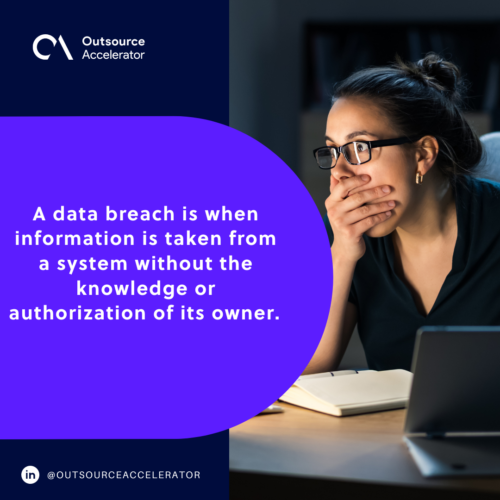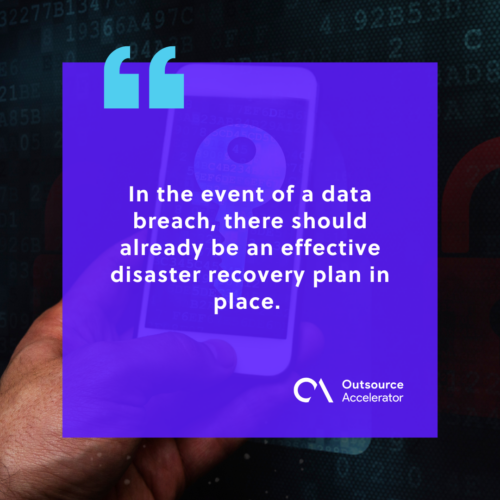What is a data breach and how to prevent one

More and more data is being transmitted over the internet everyday. This doesn’t just include what order we placed for lunch, but also credit card numbers, healthcare histories, secret program codes, and the like.
A lot of that is held by large corporations we trust to keep them safe, but if it all leaked[1], like in a data breach, that would be a very bad thing indeed.
What is a data breach?
A data breach is when information is taken from a system without the knowledge or authorization of its owner.
Historically data breaches have leaked sensitive, confidential information, such as customer data and corporate source code.
As the world becomes more connective, the risk of a data breach occurring increases[2]. We have come to value convenience over security, resulting in many digital products being released with little security testing. This only makes it easier for data to slip through.
Data breaches can affect both small and large corporations. The latter are more common as they offer larger payloads for cybercriminals.
Large amounts of personal data can be sold on underground markets. Suffering a major data breach would be a potentially destructive incident for a company.

How data breaches happen
Not all data breaches happen intentionally. Here we have the several ways it can occur:
Accidental leak
A data breach may occur because of configuration mistakes or lapses of judgment in handling data.
Even an employee using a co-worker’s device and accessing files without permission can constitute a data breach.
Insider threats
Many times, the criminal instigators of data breaches are those who already had access to the system. Internal threats usually do this for personal gain.
Malware
Malware is any malicious software designed to steal data or wreak havoc on a system. Attackers can place malware into the flaws of a system’s security in order to gain access.
Phishing
Phishing is one form of social engineering. This tactic is commonly used on lower-ranked employees, though higher-ranked ones may also be targeted.
Cybercriminals pose as trustworthy people to fool employees into handing over sensitive information.
Brute force attacks
This is when attackers throw subtlety out the window. Using specialized software tools, attackers create codes and programs to throw against your system defenses.
They do this until the system has been corrupted enough for them to swoop in and steal data.
Physical breaches
Attackers gain access to physical locations to cause a data breach. This may also happen with lost or stolen devices left unsecured.
Vulnerabilities
The actual system containing the information may not be very secure. Vulnerabilities are flaws in the system that attackers can exploit.
Lack of encryption, access controls, or wide open networks can all be vulnerabilities for a data breach.
How to protect your business from a data breach
Because there are many ways a data breach can be caused, companies should implement a holistic approach like the following for protection:
Enterprise strategies
For the business’s top brass and managers, here are some methods they can take.
Patch systems and networks
Outdated software bring vulnerabilities that hackers can exploit. Ensure the company’s IT administrators update systems when options are available.
Implement security solutions
Regularly perform checks and security audits in your system. Companies should develop processes to identify vulnerabilities and how to address them.
Such solutions may take the form of:
- Access control – employees should only be given access to information necessary to do their jobs. This reduces the attack surface of a potential data breach.
- Encryption – companies should encrypt their data with SSL/TLS encryption, including data at rest stored in their servers or employee devices.
- Network security – companies may apply the use of firewalls, secure web gateways, Distributed Denial-of-Service (DDoS) protection, and data loss prevention (DLP) software.
- Multi-factor authentication – multiple codes needed to enter an account will strengthen identity management, prevent impersonation, and reduce the risk of a data breach with lost or stolen devices. The use of a password manager may also be helpful.
- Privileged access security – privileged system accounts are often targeted by cybercriminals during a data breach. Prepare solutions to monitor and control access to these.
- Expert threat detection and response tools – these will automatically identify and weaken malware, phishing, ransomware, and other malicious activities.
Outsourcing cyber security services through reputable BPO firms like Eclaro can help businesses bolster their cyber defenses without incurring high costs. It also ensures that their data — and that of their customers — are looked after by experienced and professional cyber security specialists.
Create a response plan and contingencies
In the event of a data breach, there should already be an effective disaster recovery plan in place. This will minimize confusion by being ready with contact persons, disclosure strategies, and specific mitigation steps.
Employees should also be aware of the plans and steps so all bases are covered.

Educate employees
Inform employees about the threat of data breaches and train them to prevent it. Social engineering tactics in particular should be watched out for.
While education is important, companies should also invest in insider threat protection services to actively monitor for employees who may have turned malicious or negligent with data handling policies.
Employee strategies
Employees must also take some personal responsibility in protecting their company’s data, as they also handle confidential information.
Here are a few practices employees can do:
Keep track of receipts
Questionable and sudden transactions on your accounts are the first sign that a data breach has possibly occurred. Be aware of the charges you make and investigate unauthorized changes to your accounts at once.
Be skeptical
Social engineering preys on the gullible to cause data breaches. Train employees to be critical and vigilant about the emails and messages they send and receive and to whom. Be especially wary of messages that may contain malware.
Secure devices
These include laptops, mobile devices, and wearables. Anything connected to the company system is a possible entry point for attackers. Ensure these are protected by updated software.
Be familiar with company guidelines
Strictly follow company guidelines regarding digital security, and know who to report to in the leadup to a data breach.







 Independent
Independent




